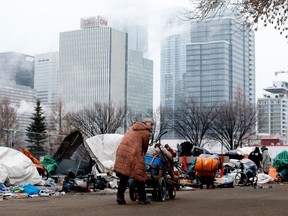
Article content
When it comes to homelessness, our imaginations are failing us. We slip into abstraction. Write it off as a symptom. Or we moralize, chalking homelessness up
to personal failure, addiction or mental illness.
If we’re going to do anything about it, we’ll need to be clear-eyed. Edmonton lost 421 residents last year, an all-time high. More than 4,000 Edmontonians don’t have a permanent home, another all-time high. According to the city’s projections, one in four renters are paying more than they can afford on housing, meaning thousands more are on a knife’s edge.
Advertisement 2
Article content
This week at City Hall, council will mull the fate of 11 surplus school sites. Surplus school sites are ripe for reimagining. Developers often set aside lands for schools, but they aren’t always needed or built. Fifteen years ago, about 20 were returned to the municipal reserve. Council earmarked the majority for affordable housing development. But most sites have remained undeveloped, slowed by community pushback, financial pressures, and non-profit sector capacity.
Now with federal support, the city has an opportunity to move the slow march to a sprint, expediting new affordable housing over the next three years with help from the Housing Accelerator Fund.
Council must not let this opportunity slip by. Shovel-ready land is one of the biggest obstacles to affordable housing. These 11 sites could make a real difference, and by increasing the supply of low-cost affordable housing, council could take pressure off the lowest part of the market. One decision this week could prevent hundreds from falling into homelessness in years to come.
It’s easy to imagine homelessness as an intractable problem, blaming individuals or entire communities. But we’re probably overthinking it to the point of policy paralysis. In 2022, American housing scholar Gregg Colburn and data journalist Clayton Aldern pointed to a different way of seeing the issue. “Homelessness is a Housing Problem” digs deep into national data, making a simple, compelling argument: Homelessness goes up when rent climbs and vacancies drop.
Article content
Advertisement 3
Article content
Regions with lots of cheap housing – in the U.S., the South and Midwest – have lower rates of homelessness, regardless of drug use trends, poisoned supply, or rates of mental illness. Areas with higher rents and lower vacancy rates struggle more with homelessness.
Canadian data bears that out. According to researcher Nick Falvo, every percentage rise in monthly real rent for affordable units in recent years has meant between 1.4- and 2.5-per-cent increases in emergency shelter admissions. Rising rents mean more encampments, more encounters with the justice and health-care systems, more burden on frontline resources that our taxes cover.
From the 1960s to 1980s, all levels of government built social housing. There was a widespread understanding that housing was a right for all Canadians, and providing adequate housing was a social good that benefited all of society. So governments built housing available for people with low incomes and fewer options, and they also provided support for co-operatives and other non-market interventions. Those buildings are still the majority of 15,000 affordable homes in Edmonton, though many are reaching the end of their viable lifespans.
Advertisement 4
Article content
In the 1990s, governments sought to shrink their budgets, making adequate funding for housing and other services unsustainable. They began leaving social housing out of plans, passing the buck to lower levels of government – without providing the actual bucks to make it happen. Despite assurances that the market would take care of it, non-market housing stopped getting built. The market did not – and will not – solve homelessness.
By the time governments really recognized a growing housing crisis – prompting a National Housing Strategy in 2017 – we’d lost two generations, along with the will and structures to effectively build and manage housing to meet everyone’s needs.
If we don’t start fixing this deficit soon, we’ll need to imagine a far-worse future. Edmonton is growing explosively, adding 55,000 new residents in 2023, with another 110,000 expected by 2026. New residents are already putting pressure on Edmonton’s rental markets, which will push more and more Edmontonians over the edge. And more of our aging affordable housing stock will likely fall off the market.
Advertisement 5
Article content
Homeward Trust Edmonton’s most recent six months of data already hint what could lie ahead. There were 667 unsheltered people in January. By July there were 1,026. Over that same time span, shelter use went from 469 to 726.
But one of the most telling numbers is the homelessness we don’t see, people in provisional housing, typically couch-surfing or in provisional housing after evictions. In January, there were 1,592 individuals in those provisional situations. That total rose to 2,259 in July.
Edmonton’s rapid growth is a recipe for even more homelessness, unless we start making adequate housing a reality with land, resources, and partnerships. Council has an opportunity this week to take leadership, to start building a better future. Imagine the difference it could make.
Bradley Lafortune is executive director of Public Interest Alberta.
Article content
